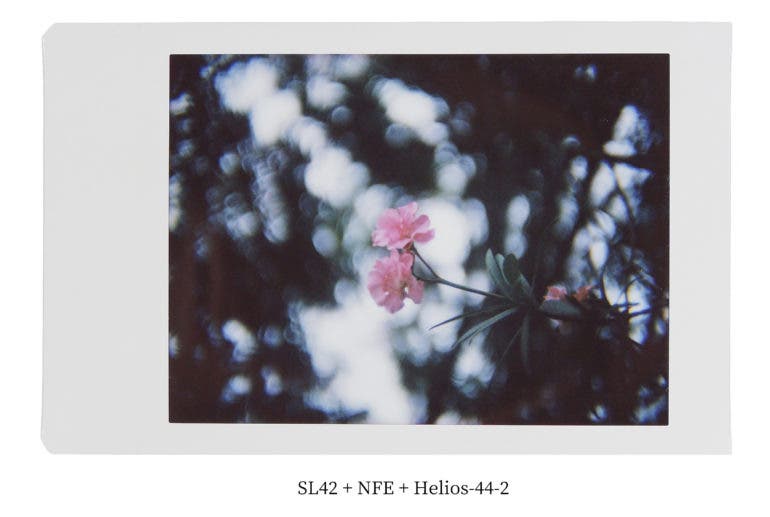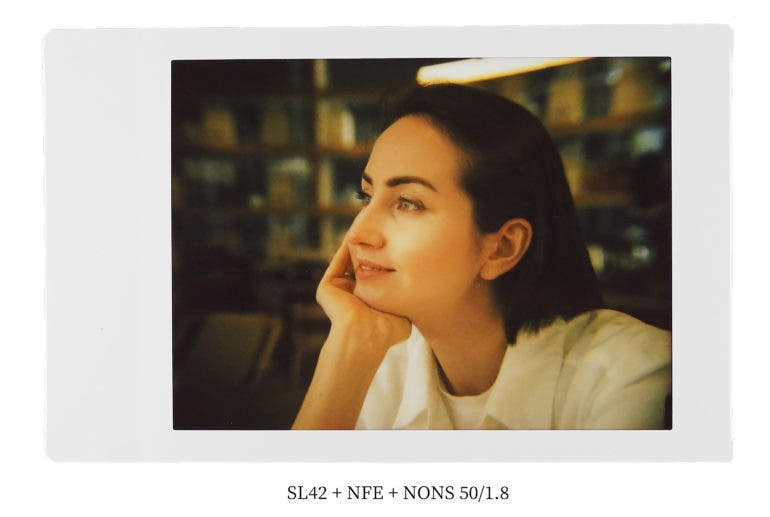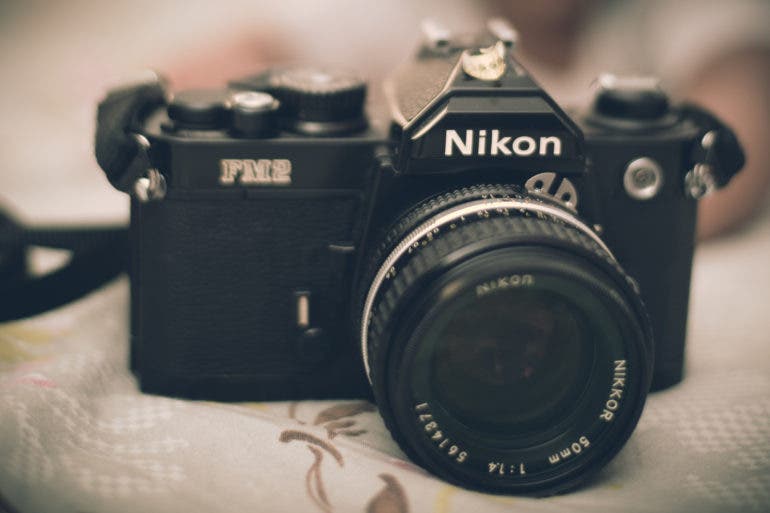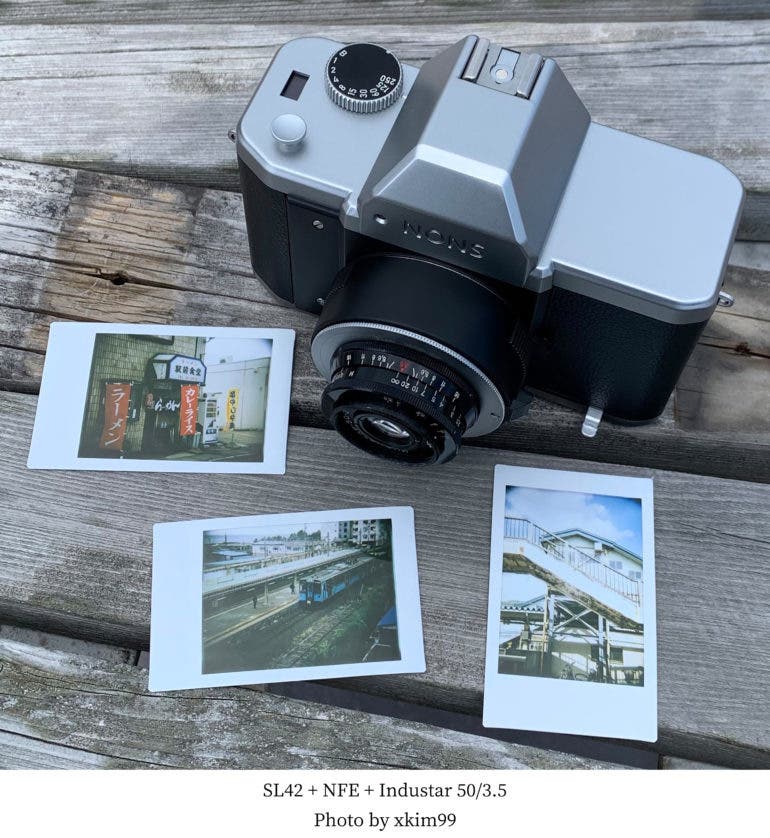The NONS SL42 Camera: Everything You Wanted to Know
We’re streaming daily on Apple Podcasts, Google Podcasts, Stitcher, Pocket Casts, and Spotify! You can also listen to it right here on the Phoblographer.
“The process of shooting film is fascinating”, says Dingsheng WU, Business Development Manager of the NONS SL42 camera line. Having successfully launched their first SL42 camera with Instax film support last year, NONS is back with an updated camera in 2 different colors in 2021. They now support EF mount lenses, which can further be adapted with a plethora of other lens mounts using manual adapters. Backers can get ready to use M42, Nikon F, Contax/Yashica C/Y lens and more. Plus, they’ve almost eliminated the heavy vignetting issue that was a mainstay of the 1st release. Our Editor in Chief Chris Gampat bought one of these cameras. He’ll be writing about his experiences with it in a future post.
The original NONS SL42 was the First Instant/Instax M42 Mount SLR Camera. Instax cameras with interchangeable lens support aren’t new. You were, however, limited to the lenses these cameras came packaged with. The NONS SL42 didn’t have this restriction and allowed you to use pretty much any M42 mount lens you wanted. Love it or hate it, though, the system created a heavy vignette around the resulting image. The team at NONS has corrected this with the addition of a NONS Format Extender (NFE) in the new campaigns. This effectively magnifies the image from the lens to reduce the vignette to a large extent. It still uses Instax film like its predecessor. It also includes an inbuilt light meter now.
What features make up the All New NONS SL42?
Features taken from their Kickstarter page:
- Interchangeable Lens – SL42 is a passive EF mount camera, compatible with EF lens, and also hundreds of vintage lenses(M42 mount, Nikon F, Contax/Yashica C/Y, etc.) with an easy-to-get adapter(no electronic signal to auto-focus or adjust electric control aperture).
- Instax Mini Film – SL42 works with the widely-available Instax mini film.
- Single-lens Reflex (SLR) – The prism-based SLR viewfinder makes it easy to frame and focus.
- Integrated light meter – The display panel will show recommended F number for proper exposure. SL42 is perfect for both pros and beginners.
- NONS Format Extender (NFE) – an EF to EF mount adapter including 3 glass elements. It will extend the full-frame image field (36 x 24 mm) to medium format (62 x 46 mm). Less vignetting, more inspiration.

The Phoblographer: Please tell us about yourself and your background in photography. What is the story behind the name NONS?
Dingsheng WU: The NONS team comprises designers and engineers – 5 members, including full-time and part-time. We are photography amateurs and have used cameras from modern types to classic models. DSLR, digital mirrorless, Fujifilm instax series, Polaroid SX-70, Mint TL70, Hasselblad 500CM.
The name NONS comes from the first 4 characters of NOn-SMart. It is obviously not smart for us to make a brand new SLR at this moment since the traditional camera manufacturers have been switching their main product line from SLR to mirrorless.
On the other hand, non-smart is also the core of our product. We did not plan to make this product a smart device with functions such as auto exposure, autofocus, etc. This product needs you to think more. You should try to communicate with it, feel it then achieve your target by manual control.
We have used a lot of smart devices in our daily life. We would like to make a difference and bring more interesting non-smart toy cameras in the future.

The Phoblographer: What inspired the creation of the original SL42 camera?
Dingsheng WU: The beginning is quite simple that we wanted an instant camera that could take photos with M42 lenses and manual focus at the same time. Then it is a long road to solve the problems step by step.
We think the SLR structure is the best way to get accurate focus.
The reflex structure issue took us a lot of time. The reflex mirror of classic SLR is a 45-degree flipping type. It will shade the light path for Instax mini film, which has a diagonal length almost twice that of full-frame film. Then we designed a horizontally moving reflex structure. SL42 should be the first batch produced camera with this kind of reflex structure based on our research.
We have received requirements for EF mount instead of M42 mount during our first campaign. Shorter flange distance and more existing mechanical adapters make EF mount more compatible. SL42 is designed for interchangeable lenses, and it is worth scaling the compatibility by changing to EF mount.
Usually, we need an extra light meter – either an app or a hot shoe meter when using classic film cameras. Using the first SL42 prototype is the same feeling. Modern ambient light sensors are small and accurate, so we leave the aperture calculation to the camera itself.
The image field of the full-frame lens is 36 x 24 mm, which is significantly smaller than the Instax mini film of 62 x 46 mm. Then the big black circle (vignetting) is left on the film. After hearing so many voices about vignetting, we started to look for an optical solution as soon as the production of SL42 ended. Then the NONS format extender came out with the second campaign.
I think we make this product quite straightforward, like running a marathon.
The Phoblographer: Being a particularly challenging year due to the pandemic, what pushed you to go ahead with the Kickstarter campaign for the original Nons camera last year?
Dingsheng WU: We have decided to do this project before the pandemic. The prototype was ready on time in late 2019, so we followed our schedule to launch the campaign to test the market, get product feedback and raise part of the start-up capital.
We did not realize that the epidemic would bring global impact when the campaign started in February 2020.

The Phoblographer: What were the challenges to meet the milestones and deadlines for this during the pandemic. How successful did you feel the response to the campaign was?
Dingsheng WU: The start date of batch production was delayed since the manufacturers shut down due to the pandemic. It was hard to travel around, especially when we had to explore new suppliers. Since we have worked remotely for a while, the efficiency of design and development was not as good as work in the office.
By now, we are still affected by the pandemic, especially the price increase from upstream suppliers.
Our backers were warm-hearted and gave us a lot of suggestions. We are feeling to complete the product with our backers together. Changing the mount from M42 to EF was a good example. We adopted backers’ suggestion to make SL42 compatible with more lenses and adapters.
Even the absolute amount of money raised is not that much, but it is enough to support our confidence in moving forward with this project. The campaign also caused some reports and discussions beyond our expectations. We are pleased with the feedback from the market.
The Phoblographer: Deciding on Instax over Polaroid and Zink- was this an easy choice to make?
Dingsheng WU: Polaroid is a great company with so many amazing products. There is a lot of ingenuity in the design of SX-70, and it keeps inspiring us.
Technically, the exposure surfaces are different between Polaroid film and Instax film. The image of Polaroid film will be mirrored if it was exposed in the way of a classic 135 camera. It shall be corrected by reflecting the light path once. But the Instax film could be exposed directly through a lens the same as a 135 camera.
Polaroid film is more expensive than Instax film as well.
Theoretically, we do not think Zink is film photography, so we did not consider making this kind of product.

The Phoblographer: What’s changed between last year’s edition and the new ones? Why bring out new editions so soon after the first one?
Dingsheng WU: The first one launched in 2020 is Mark 1, and it has been discontinued after the launch of Mark 2. The other 2 new models (links in the question) launched this year are both Mark 2.
Compared with Mark 1, Mark 2 updated the power system from 2 AA batteries to an integrated Li-ion battery. NONS format extender (NFE) came with Mark 2 as bundle sales.
We have heard the discussion about vignetting from the beginning of the first campaign. Most people prefer less vignetting, so we immediately started the R&D of the extender after the first campaign ended. We cannot wait to share the extender after testing the prototype.
The only difference between the 2 new models is color – silver black, and full black.
We have also received several messages about the black version during the campaign. Finally, we found a satisfactory black color after testing several surface finishings.

The Phoblographer: With digital photography making photography and image sharing so much easier, why do you feel photographers are going back to film again so much? What is it about those faded colours that makes it so popular?
Dingsheng WU: We also use digital cameras very often, and the smartphone camera should be most frequently used. The grain, tune, and faded colors of the film gives more emotion to the photos. This is one of the reasons we think it has become popular.
In addition, the process of shooting film is fascinating. It obviously takes more time to think of and wait for the result compared with simply pressing the shutter button for quick sharing. This shooting process itself is a kind of pastime, and it makes me feel relaxed.

The Phoblographer: What type of photographer do you feel this camera will appeal most to? Who would be most motivated by using this camera?
Dingsheng WU: I think this camera appeals to the photographers who own vintage lenses, people who pursue innovative and unique photography experiences.
The instant camera enthusiast who desires better image quality and precise control should also be motivated.
The Phoblographer: Was there a particular camera model that inspired the design of the NONS? What lens do you most enjoy using with it?
Dingsheng WU: SL42 looks like a magnified classic 135 camera, such as Nikon FM2, Canon F-1, and Pentax Spotmatic. But the function is indeed very original while there are currently no reference products on the market.

I enjoy Helios-44 quite much. Its swirly bokeh is very distinctive and highly recognizable. It is considered to be one of the most mass-produced lenses in the world. You could easily find it in the market at a good price.
In addition, the most commonly used lens is our kit lens. Not for advertising, the large image field, 50 mm focal length, 0.45m closest focal distance, and f/1.8 max aperture of the kit lens are all very practical.
Super-Takumar 35/3.5 is frequently used in recent weeks. There is almost no vignetting on the Instax mini film when shooting with this lens and the extender.

The Phoblographer: The shape of the old school pentaprism is one of the visible standouts of the camera for me. ‘6 months and more than 1,000 miles’ – please tell us more about this phrase of yours.
Dingsheng WU: In Mar 2020, we came to the first candidate of pentaprism suppliers. This is one of the leading Chinese optical manufacturers located in Henan province. Its previous products were supplied to well-known Japanese camera manufacturers, but now the production line of roof pentaprism has been discontinued for many years. Since our demand is much less than previous Japanese manufacturers, we have been rejected.
The pandemic disrupted our schedule. Then we went to Jiangxi province in May 2020 to continue negotiating with other optical suppliers but failed.
In the following months, we visited optical factories in several different cities in Guangdong province. By this time, we had found 8 suppliers, but all of the negotiations were in a similar situation. Mainly because our production demand was far from enough to impress them to restart the production line.
Until September, a supplier in Guangdong Province agreed to assist us in developing the roof pentaprism for SL42. They used to be the suppliers of Japanese manufacturers as well. Their engineer said he was astonished that there was still a company releasing new SLR cameras after trying SL42 prototypes.
We are proud to revive the classic roof pentaprism for SLR.
The Phoblographer: Is the viewfinder coverage 100% though? Does the Fresnel screen provide adequate support for the focus confirmation?
Dingsheng WU: SL42 is originally designed without NONS format extender (NFE). The viewfinder size is the same as the classic 135 camera of 36 x 24 mm, which shall not cover the image field of Instax mini film (62 x 46 mm). The viewfinder is acceptable when using without NFE. Some customers cannot accept the framing result through the existing viewfinder, and some use an external viewfinder instead. Most might get used to the viewfinder after shooting 1 or 2 packs of film.
Fresnel greatly improves the brightness of the focusing screen while the brightness is really important for a clear view. The current focusing screen is enough for accurate focus since fresnel provides adequate support for the focus confirmation while the resolution of Instax film is only 12 lines/mm.
Also, we know the focusing screen of the SL42 has a gap compared with the classic SLR using micro prism. We understand that the focusing screen is very important to improve the experience of SLR. We have received related feedback and keep sourcing better focusing screens. Currently, the process of sourcing is similar to the early stage of the pentaprism. Since temporarily we cannot find a proper supplier to customize a high-quality focusing screen for our products, now we cannot give a schedule for updating the focusing screen.

The Phoblographer: While there have been others, the Nons 42 is probably the first to support so many lens mounts. How does it feel to be a pioneer in this field, and what’s the future for this? Any plans for a similar TLR?
Dingsheng WU: We are very excited to bring such innovative stuff to the market. We want to make a difference and keep creating interesting toy cameras.
It is very hard to make new products. Customers could find it a little bit harder to understand the new concept. But it is still very interesting and worth keeping going.
We have a mint camera TL70. We think its completion has already been very high in combination with TLR and Instax. Therefore, we do not have plans for TLR recently, and our main product sequence will still be SLR in the short term.
All images (unless specified) were provided by Dingsheng Wu. Used with permission. Visit the NONS website to know more about the camera. You can pre-order one too.